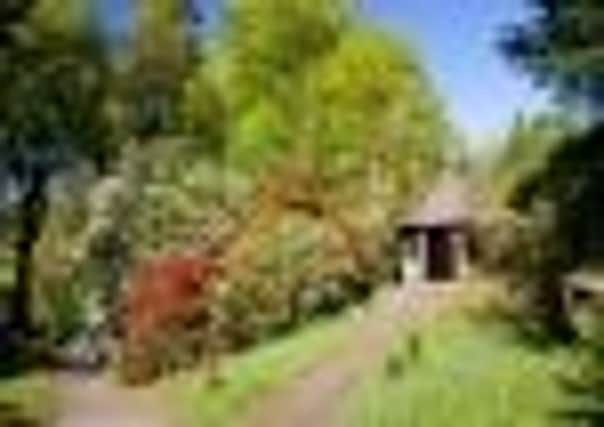The specimen trees at Ardkinglas are magnificent, but there is much else to enjoy in the woodland garden


Without their efforts, and the forward-thinking commitment of the families who financed their travels, our lives would be much poorer.
Walk into this 25-acre privately owned garden and your eye is immediately drawn upwards. Here is the giant fir, Abies grandis, the American native introduced by Perthshire-born David Douglas. Planted in 1875, this specimen is reputed to be one of the tallest trees in Britain.
Advertisement
Hide AdAdvertisement
Hide AdHere, too is the striking 250-year-old European silver fir, Abies alba, its rugged 31ft diameter trunk a magnet for both children and adults. Look up the dramatic, ridged trunk of the western red cedar, Thuja plicata, planted nearly 140 years ago.
Or discover the 70ft tall Patagonian cypress, Fitzroya cupressoides, which records suggest was planted in 1870 and rare even in its native Chile due to the quality of its timber. The final member of the famous five is the golden plumed Sawara Cyprus, Chamaecyperis pisifera.
Ardkinglas owes much to its long history of private ownership. Records suggest there was a garden here as early as 1640, which later formed part of a wider, informal 18th-century designed landscape. After the Scottish Uprising in 1745, the Campbell family began planting trees, and it was their descendants who began planting seeds acquired from David Douglas.
The growing conditions were ideal: warmed by the Gulf Stream, the site benefited from an annual average 100in (245cm) rainfall that filters rapidly through the free-draining sandy loam.
In 1905, the estate was acquired by the Noble family. In the 1930s, Sir Michael Noble MP began planting rhododendrons and azaleas, using the contents of two railway wagons of species shipped from Bodnant Castle in Wales. Many of these plants were grown from seed collected in China and the Himalayas.
Planting continued until the mid-1960s, when the estate was divided between two Noble brothers and the garden fell into neglect. Restoration work began when Johnny Noble, who founded the Loch Fyne Oyster Bar, reassembled the two parts of the estate. After his premature death six years ago his nephew, architect, David Sumsion, inherited the estate. He now lives at Ard-kinglas with his wife Angela and their children Isabella, 14 and Sophie, six.
Estate office manager Jean Maskell explains: “Despite the expense of maintaining a garden of this size, the family are committed to retaining the space because of the horticultural importance of its trees and rhododendrons.” Help comes from horticulturist Glyn Toplis and gardener Steven Williams.
Ardkinglas’s 25 acres have a surprisingly intimate quality as you explore the network of narrow paths that thread the glen. Jean explains: “This is a garden to discover as you walk around.”
Advertisement
Hide AdAdvertisement
Hide AdFrom the positioning of trees in the landscape, the ribbons of primula that line the burns and the red, pink and yellow of strategically placed rhododendrons in spring, there are surprises around every corner. As spring arrives the rich fragrance of azaleas, or the creamy branches of Osmanthus delavayi, fill the air. Bluebells carpet the woodlands.
The quiet paths, where you occasionally meet other visitors, lead to the elegantly arched bridge over the River Kinglas where grey wagtails traditionally nest in April. From here you can climb back up the side of the burn, or choose a wider path to circle round.
The pockets of new plantings bring colour and interest to the scheme. The Japanese native, Malus tschonoskii, chosen for its bold red autumn foliage, is paired with native Sorbus aucuparia. Other recent introductions include moisture-loving alders such as the golden-leaved Italian alder, Alnus cordata and A rubra – the latter hung with red catkins in autumn.
“We are trying to create year round interest,” Jean explains “and to make up for the years when the garden was neglected between 1966 and 1993.”
When not in flower, rhododendron foliage combines with ferns, and carpets of bluebells to soften the rugged outline of established trees. Many of the paths are moss-lined while the yellow flowers and shiny leaves of skunk cabbage, Lysichton americanus, are often seen. The well-labelled collection of rhododendrons, chosen for their shape, form and varied foliage, is an education in itself.
The majestic Rh Falconieri boasts big green leaves in addition to pale yellow flowers, while Rh Fortunea has scented white blooms, here contrasted with a waterfall of pale pink flowers produced by Rh Vernicosium. Varieties of richly coloured bubble gum pink camellias lighten shady corners.
Often taken for granted, the work of the plant collectors has given us a rich and inspiring legacy. Recognition is also due to the vision of successive owners willing to invest in the unknown plants that grew to add drama and interest to our landscapes.
Ardkinglas Woodland Garden is one of the Glorious Gardens of Argyll and Bute, www.gardens-of-argyll.co.uk; the garden is located at Cairndow on the A83. It is open all year round, from dawn to dusk. There is an activity sheet for young children and dogs are allowed on leads. Ardkinglas House, www.ardkinglas.com, is open on Fridays for a guided tour, but booking is essential.